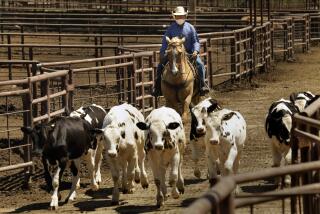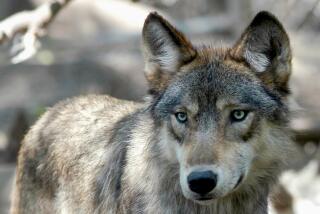Texas driving its cattle north amid drought
The cowboys rose well before dawn, stars still high in the West Texas sky. They strapped on spurs and leather chaps and climbed into their saddles for one last roundup.
They didn’t have to do much to rustle the cattle from the dusty flats about 220 miles west of Dallas. Hundreds of hungry black Angus and Herefords, tired of foraging for scarce, drought-dry grass, came running — drawn by the hope of feed. The cowboys herded the youngest, thinnest and weakest animals into a separate pen, some with ribs and hipbones jutting after weeks without a decent meal.
The best cattle from Swenson Land & Cattle Co. Inc. will make the trip north.
It’s a journey born of desperation, a costly cattle drive fueled not by tradition or buyers at Midwest packing houses, but by the desire to survive the lengthening statewide drought.
Managers at Swenson and the state’s other large ranches have been scrambling to ship cattle to verdant northern land they have leased in an effort to save their trademark brands and to continue taking advantage of the worldwide demand for beef.
The number of breeding cows shipped out of state increased 140% in September compared with the same month last year, with 145,000 cattle exported, according to the Texas Animal Health Commission.
By January, about 12% of Texas’ roughly 5 million head of cattle will have disappeared since last year — shipped, slaughtered or sold, according to David Anderson, an economist with the Texas AgriLife Extension Service, an agriculture education agency based at Texas A&M University.
Swenson has paid about $70,000 to ship 1,200 head — two-thirds of the herd — to Tryon, Neb., and Lusk, Wyo. They are all cows, the precious breeding stock they have cultivated since Swedish immigrants staked out the territory in the 1860s.
Swenson’s double-deck trucks will trace some of the same routes followed by the 19th century cattle drives up the Chisholm and Goodnight-Loving trails. Such massive drives would no longer be possible on hoof, the prairies long ago fenced in.
“There’d be no way to water cattle,” Swenson General Manager Dennis Braden said from behind his gray cowboy hat and matching mustache. “These old cows are so weak, we’d go to killing them.”
Braden stared out at the parched land from his downtown office, its walls covered with portraits of past ranch managers, almost all in cowboys hats, many holding cigarettes and grinning during better times. “Between here and Kansas, there’s no place to water cattle because we’re droughted-out and the tanks are good and dry.”
Swenson has sold 1,000 head of cattle this year and is struggling to maintain the remaining 500 cows, 100 bulls, and 1,300 calves.
An August survey by Texas and Southwestern Cattle Raisers Assn. found that 84% of ranchers had reduced their herds.
Ranchers would prefer to expand their herds, given that the national cow inventory is at 1950s levels, Braden said, while the national human population has more than doubled since then. Plus, U.S. ranches increasingly serve the world market. Texas, with the nation’s largest cattle industry, provides 16% of America’s beef. U.S. beef prices are expected to increase this year as much as 8%, twice the increase in overall food costs, according to the Department of Agriculture.
“For the first time in my life, we had a chance to make some real money,” Braden said.
When word spread among Stamford’s 3,052 inhabitants that Braden was sending cattle north, some worried that the livestock they were accustomed to seeing around town would disappear forever.
“Used to be, you would see horses and cattle by the bookoodles coming in. Now it’s not,” said Sandra Rhea, curator of Stamford’s Cowboy Museum, full of faded rodeo snapshots. “They’re all going up north, and there’s no telling when they’re coming back.”
Texas has suffered more than $5.2 billion in agricultural losses this year from the dry spell, including in the cattle industry. No relief is in sight and the state climatologist says this could be the start of a 10-year drought, part of changing weather patterns worldwide.
A few months ago, managers of Swenson and the larger spreads called a crisis meeting at Tongue River Ranch, about 95 miles north of here. They agreed to send Braden and the manager of the Four Sixes Ranch to scout northern pastures that had received above-average rainfall, and ended up leasing land in Colorado, Wyoming, Kansas, Nebraska, South Dakota and Montana.
Many say they plan to return at least some cows once Texas greens, but admit it could be years before the cows come home.
Smaller Texas ranches unable to lease land have been selling out, sending to slaughter the calves and cows they cannot afford to feed.
At a recent auction in Lampasas, about 70 miles north of Austin, buyers for outfits in Colorado and Wyoming lined up to bid on skinny cows, bulls, steers and calves. Many sold for $1 a pound, down from $1.70 last year.
A few cattle in the auction ring had cheeks studded with prickly pear cactus spines and legs sheathed in “white socks” of pale caliche mud — signs they had been searching for food on the range as hay and feed prices skyrocketed.
“We can’t get hay — we’re feeding them stuff you wouldn’t feed a goat,” said Bob Garner, 58, a rancher at the sale from nearby Goldthwaite, where hay prices have doubled and creeks have run dry.
At Swenson, local businessmen, from feed dealers to antibiotic salesmen, have stopped by to remind Braden they can ship goods to his herd up north. But he can’t afford the added cost, which he knows will take a toll on the local economy. He has already been forced to thin his staff from 14 to nine since March.
One recent day, he watched his cowboys wrestle his cattle from the scrub. He hated to see the cattle like this, the calves worst of all.
Underfed and undersized, they were too small to make the journey. Cowboys swept in on horses and pried them away from their mothers. One tried to escape. The rest just huddled together on spindly legs, lowing.
Three double-decker trucks would arrive soon for the animals strong enough to make the journey. The cowboys would prod them up a chute and into the trucks, bound for Nebraska.
molly.hennessy-fiske@latimes.com
More to Read
Start your day right
Sign up for Essential California for news, features and recommendations from the L.A. Times and beyond in your inbox six days a week.
You may occasionally receive promotional content from the Los Angeles Times.







